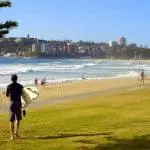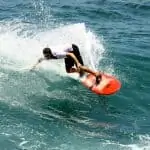Best Surf Conditions for Beginners: Every Factor to Consider
Getting the conditions right as a learner surfer can give you a huge boost in terms of your progress and development.
Go at when it’s too big and it can be pointless, or even just when the tide and wind conspire against you. As such, I wanted to answer a common question for anyone learning to surf, what are the best surf conditions for beginners? The best overall conditions for learning to surf are small waves, usually not above waist-high, with light winds and not too many people. However, other things like tide, wind, and more, need to be considered, as we will look at below.
Perfect Wave Size for Beginners: Up to Waist High
Bigger is not always better, and that is certainly true in surfing terms when learning.
[quote]This is because small waves are definitely the best size waves to learn to surf on, and they have lots of added advantages, too.[quote]
If paddling out as a beginner, smaller waves are better in that they are less powerful. This might sound counterintuitive but, provided that you are riding on a learner surfboard, then you will easily be able to catch lots of small waves without issue.
Having the right beginner board in the surf this turns even the smallest of waves into a fun playground for learning and progression.
If you are not sure what type of board you need, check out this dedicated article I prepared to help you choose the right board for your surfing level and progression.
In terms of a specific wave height, and with the right board, you will be able to ride waves that are anywhere from shin to waist high with ease and have lots of fun.
Safety
As well as catching lots of waves, these smaller waves are perfect for learners in that they are less powerful, making them less dangerous.
This is because more powerful waves demand more control of a surfboard, something which can take dozens of hours in the surf to master. Even pushing the board over (or later, under) an oncoming wave can be a major hurdle in the early days of learning to surf, so it’s best to stay in the more relaxed waves to learn.
Waves can also push the board out of your hands and potentially hit someone else, so being in the smaller waves will also mean that you are less likely to lose control of your surfboard, again making it easier for you and safer for others, so win-win.
Another huge positive of learning to surf in small waves is that you will be much closer to shore, again making your surfing experience a lot safer.
This is because you should be able to get back into shore easily if anything happens, For instance, if you forget to put your leash (or ‘leg rope’) on properly and a waves washes your board away, you can easily walk or swim in.
Similarly, staying in the small waves close to shore, if you feel a rip current, you can get back to the beach without needing to be good on your surfboard.

Learn in Uncrowded Waves
Following on from the points above about smaller waves, you should also look to learn in uncrowded waves. This will mean that you can catch more waves and also feel less concerned about collisions or bumps with others around you, making it much more fun to learn to surf.
Now, I should say I do not mean learn to surf alone, that’s not advisable. But, if you can find a spot with a few others but not too many, then that should be perfect.
The reasons for not learning to surf alone are because of having safety in numbers: you really want to have a few people around you in case of a freak accident or a sudden change in conditions (it is the sea after all!).
Nobody to Share the Waves With? Here’s What to Do
Although most surf spots around the world are busy these days, some of you might find that there aren’t many (or any) other local surfers. So, if you can’t find spots with others around and want to keep learning, then at least either tell someone where and when you are going, or go to spots with lifeguard patrols wherever possible.
To be extra safe when surfing alone, you could also get yourself a soft surf helmet from Decathlon (currently Europe only) for added protection; their soft surf helmets are both safe and affordable, so a great option to prevent any issues that might arise in a solo surf.
Best Tide: Incoming, Stage of Tide Depends on Your Spot!
Incoming Tide Usually Safest For Learning
I would always recommend beginners learn on an incoming tide. This is because there are generally fewer rip currents when the tide is coming in.
However, on an outgoing tide, you will more often notice currents that are running out to sea, in line with the tide’s movement in that direction.
As such, try to learn when the tide is coming in to help you have a safer time and usually fewer currents.
You can find out this information online easily and just plan to surf after the low tide; the tide will be incoming for a full 6 hours so you will have plenty of time to get your waves!
Stage of Tide
The best stage of the tide and the height are two other factors to consider as these can change the conditions at your local spot.
This is something that you can usually find out quickly and easily from websites like MagicSeaweed or WannaSurf.
Keep an eye out for exposed rocks or reefs at different stages of the tide to stay safe but, generally, you want to surf between the extremes of high and low tide; for more, read this full article I wrote on the subject to make sure that you get to your spot at the best stage of the tide!
Best Wind for Learning to Surf: Light Offshore or None; Direction Depends on Location
The best wind for surfing is always light, with offshore winds giving the waves a perfect form and no wind making the sea glassy and lots of fun.
In case you’re wondering, an offshore wind is so-named because it describes a wind that blows from the land out to sea, so off the shore out to sea, if you like.
However, strong winds will usually ruin most waves, regardless of the direction, so don’t expect to have fun in a howling, gale-force offshore wind!
In fact, strong offshore winds can also be hazardous for learners. This is because these winds can blow you out to sea, making it harder to paddle in. Although it sounds funny, sitting on your surfboard can really make the wind push you like a sail, so don’t overlook this fact, too!
For checking wind and conditions, I would suggest looking at a free site like WindGuru for the wind speed and note that the darker the color, the stronger the wind. Windguru is one of my go-to surf sites for checking the conditions as it also has wave heights, too, although these take a little while to get used to reading.
Swell Period: Not Really Important for Learning
You may have seen the ‘period’ listed on some surf forecasting websites. This describes the average time (or ‘interval’) in seconds between waves, so the period of time it takes between one wave passing the wave buoy and the next to arrive.
This is useful for more advanced surfing since it tells you a lot about the quality and size of the waves, but is not that important for learning to surf.
Generally speaking, the bigger the period, the further the waves have traveled across the ocean and the more organized and powerful they will be.
This doesn’t really matter when going out in small stuff but it’s something that you can start to look at as you progress in surfing.
Related Articles
Before you go, below is a selection of articles on this site that I’m sure you will enjoy after reading this one!









